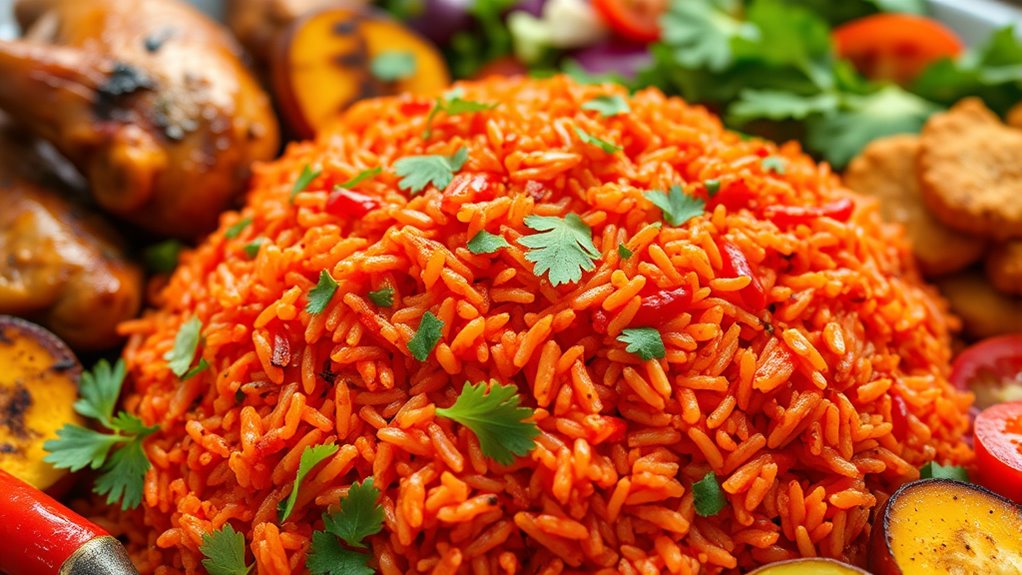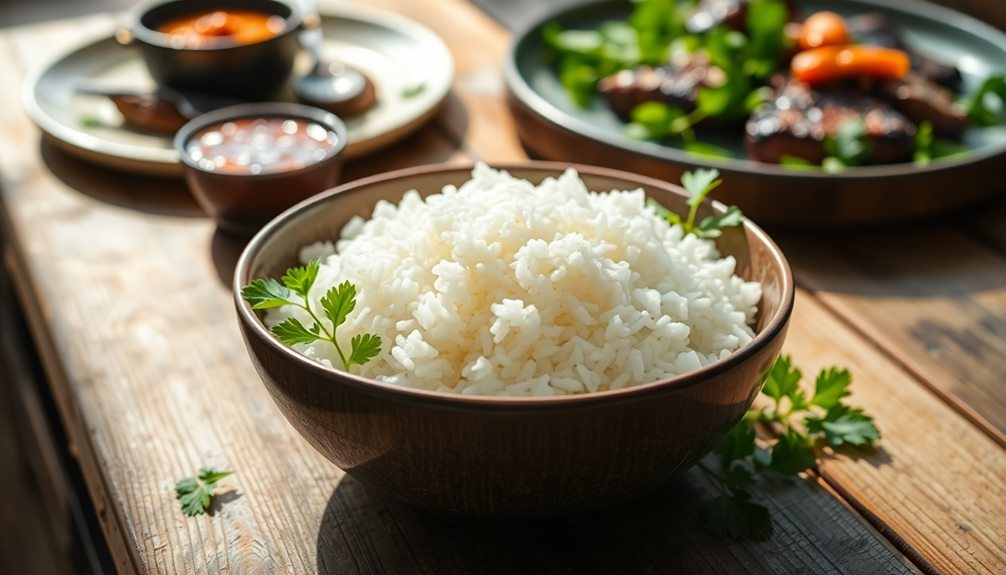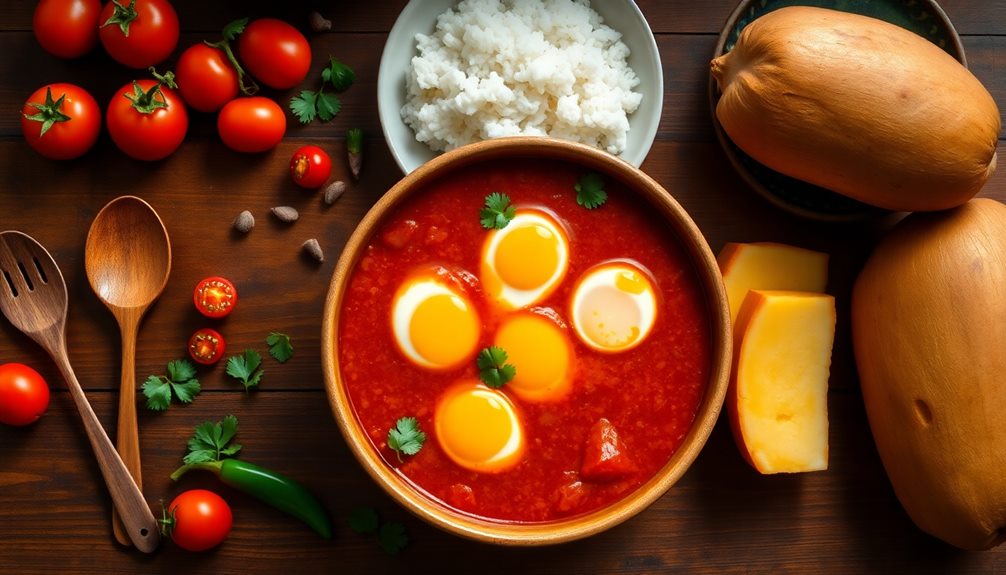Nigerian Jollof Rice is a lively, flavorful dish that’s perfect for celebrations and bringing people together. You prepare it with ripe tomatoes, red peppers, and a blend of spices, then cook long-grain rice until fluffy and infused with rich flavor. Its vibrant color and enticing aroma set the tone for any festive gathering. If you keep exploring, you’ll discover more tips and secrets to perfecting this beloved West African party dish.
Key Takeaways
- Nigerian Jollof rice is a vibrant, flavorful dish central to West African celebrations and parties.
- It features a tomato-based sauce, long-grain rice, and aromatic spices for rich taste.
- Proper preparation involves blending, simmering, and steaming to develop deep flavors and perfect texture.
- The dish is versatile, often served with proteins like chicken or fish during festive gatherings.
- Its colorful presentation and communal nature make it a symbol of celebration and shared joy.

Have you ever wondered what makes Nigerian Jollof Rice so irresistible? It’s more than just a dish; it’s a symbol of celebration recipes that bring people together. Whether it’s a wedding, birthday, or holiday gathering, this flavorful rice is the star of the party. Its vibrant red hue and rich aroma instantly create an inviting atmosphere. To master this dish, you’ll want to focus on some essential cooking tips that guarantee every bite is packed with flavor and perfectly cooked.
First, start with quality ingredients. Ripe tomatoes, red peppers, and fresh spices are the backbone of authentic Nigerian Jollof Rice. Blending these into a smooth, thick tomato base gives the dish its signature color and taste. When preparing your sauce, make sure to cook it down thoroughly; this step intensifies the flavors and prevents excess moisture, which can make the rice soggy. Using long-grain parboiled rice is also vital because it holds up well during cooking and stays fluffy. Rinse the rice thoroughly to remove excess starch, which can cause clumping.
Start with fresh, quality ingredients and cook your tomato base thoroughly for authentic Nigerian Jollof Rice.
Adding the right amount of seasoning is where your cooking tips come into play. Traditional Nigerian Jollof Rice uses ingredients like thyme, curry powder, bay leaves, and a touch of smoked paprika for depth. Don’t forget to season with salt and a little bouillon cube or stock for added umami flavor. When cooking, sauté your aromatics—onions, garlic, and ginger—until fragrant, then pour in your tomato blend. Let it simmer until the oil separates from the sauce, signaling that the flavors have melded beautifully.
Once your sauce is ready, add the rice and stir well to coat each grain with the flavorful mixture. Pour in enough broth or water to cook the rice thoroughly without making it mushy. Cover the pot tightly and reduce the heat. A key cooking tip is to avoid stirring the rice too often—this can make it sticky. Instead, let it steam and absorb all those rich flavors. For safety and optimal freshness, ensure your ingredients, especially the lemon juice used for flavoring, are fresh and properly stored to prevent spoilage.
Nigerian Jollof Rice isn’t just a meal; it’s a dish that turns any gathering into a celebration. Its versatility allows you to add proteins like chicken, fish, or beef, making it suitable for all kinds of festivities. As you perfect your recipe, remember that the secret lies in balancing ingredients and patience during cooking. With these celebration recipes and cooking tips, you’ll soon be serving a dish that not only tastes fantastic but also creates unforgettable shared moments with loved ones.
Frequently Asked Questions
What Are the Key Differences Between Nigerian and Ghanaian Jollof Rice?
You’ll notice Nigerian Jollof rice has a higher spice level, making it more vibrant and fiery, while Ghanaian Jollof tends to be milder and more tomato-forward. Ingredient differences include Nigerian versions often using more onions, bell peppers, and a variety of spices, whereas Ghanaian Jollof emphasizes a richer tomato taste with less heat. These distinctions give each dish its unique flavor profile, appealing to different preferences.
Can Jollof Rice Be Made Vegetarian or Vegan?
You can definitely make Jollof rice vegetarian or vegan. About 60% of people are now choosing plant-based alternatives, so flavor adjustments like adding vegetables, tofu, or plant-based protein can create a delicious dish. You may need to tweak the seasonings slightly, but the rich tomato base remains intact. With these swaps, you get a hearty, flavorful Jollof rice perfect for vegans and vegetarians alike.
What Are Traditional Side Dishes Served With Nigerian Jollof Rice?
You typically serve Nigerian Jollof rice with fried plantains and fresh salad options. The crispy sweetness of fried plantains complements the savory, spicy rice perfectly. For salads, you might choose a simple tomato and onion salad or a vibrant vegetable mix to add freshness and crunch. These sides balance the rich flavors and make your meal more enjoyable, creating a well-rounded Nigerian feast.
How Long Does It Typically Take to Cook Authentic Nigerian Jollof Rice?
You’ll typically spend about 45 to 60 minutes cooking authentic Nigerian jollof rice. Using proper cooking techniques like sautéing the tomatoes and onions first helps develop flavor, while stirring occasionally prevents burning. Ingredient variations, such as adding extra vegetables or different spices, may extend the cooking time slightly. Keep an eye on the rice to make sure it absorbs the flavors fully without becoming mushy, resulting in a perfect, flavorful dish.
Are There Regional Variations of Jollof Rice Within Nigeria?
You’ll find that regional variations of Jollof rice in Nigeria are as diverse as the country itself. Different areas use unique ingredients like smoked fish, vegetables, and spices, making each version a flavor explosion. Cooking techniques also vary, from slow simmering to quick stir-frying. This culinary kaleidoscope means your taste buds will travel through Nigeria’s rich cultural tapestry with every bite, creating an unforgettable feast.
Conclusion
Don’t let the unfamiliarity hold you back from trying Nigerian Jollof Rice. Its bold flavors and vibrant colors make it a perfect centerpiece for any celebration. Even if you’re new to West African cuisine, you’ll find it easy to prepare and incredibly satisfying. Once you taste its rich tomato base and fragrant spices, you’ll understand why it’s a party dish loved across the region. Give it a try — your taste buds will thank you!










